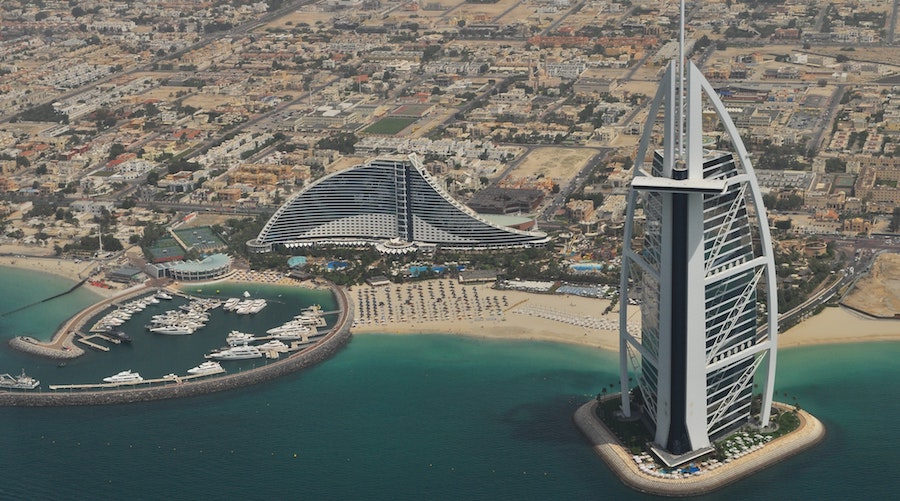Summary
3D printed buildings in Dubai are making an impression around the world. Here’s why. And here’s how it works.
3D printed buildings in Dubai are really turning heads. The United Arab Emirates launched an initiative in 2018 to become a world leader in 3D printed construction technology. The country’s capital and largest city, Dubai, is already home to the world’s largest 3D printed office building.
The Arabic country is committed to becoming an innovator in the space to offer affordable and eco-friendly solutions to its community. Dubai hopes to lead the world in additive manufacturing as a way to enhance its leadership as a center of technology.
3D printed buildings in Dubai will be more and more commonplace. Sheikh Mohammed bin Rashid Al Maktoum, Vice President of the United Arab Emirates, has pledged that by 2030, 25% of all new construction in Dubai will be 3D printed. This will include all types of real estate in Dubai, including government facilities and parks, buildings for humanitarian causes and mobile homes, galleries, stores, residential structures and more.
Dubai is a modern, luxurious city in the heart of the desert. Interestingly, roughly 85% of Dubai’s population is foreign, and an estimated 15% are Emirates. Arabic is the official language and Islam is the official religion.

Burj Al Arab in Dubai, United Arab Emirates
And it is in this vibrant and diverse city that 3D printing construction is making its world debut as an option for useful and beautiful construction rather than simply a curiosity.
But how does it work? And what is the attraction to 3D printed homes and offices?
3D Printed Buildings in Dubai—How It Works
Dubai’s 3D printing construction and building sector will focus on printing lighting products and bases and foundations from 3D printers. From there, traditional construction methods will complete the final phases of the projects.
3D printed homes are fast, affordable, and sustainable. They are also great buildings for areas with intense climatic conditions, such as the desert, making Dubai a perfect destination for this construction to flourish.
Here’s how the 3D printed construction process used in Dubai works step-by-step.
1. Create a Blueprint
The first step in 3D printing home building construction is to create a blueprint. This can be done through a modeling software program, which allows the builder to easily customize the home or structure.
Unlike with traditional construction, tricky features such as arches can be created in the software that would be difficult to create with traditional construction methods and materials..
3DVinci Creations, a printing service in Dubai, has partnered with London-based AI company Ai Build to create these blueprints through modeling software and then building the 3D printed structures using robots.
2. Send design to the printer
As soon as the blueprint is approved for the build, it is then sent over to the printer for preparation. Once the printer processes the digital file, the build platform will need to be prepared and the raw materials will need to be filled.
Spanish conglomerate group ACCIONA is a popular 3D printing company with offices in Dubai. They recently expanded and opened a construction center featuring the world’s largest operational powder bed 3D printer!
3. Print materials layer by layer
Once the printer is ready for execution, it’s time to prepare the building site before printing begins. Rails are typically installed where the foundation and walls will go to help guide the robotic arm to lay the paste-like build mixture during printing. Concrete is the most popular paste mixture used during 3D construction today.
When the printer begins to lay the foundation, it does so through a process called material extrusion. Here, the printing material is heated and then squeezed out through a nozzle and directed by a robotic arm to the layering site. A heater is then used to dry the material quickly so that another layer can be added.
4. Install additional construction
Once the 3D printing process has been completed, the home’s foundation and walls are built. This process can be done in just a few hours, but in order to complete the build, additional construction is still needed.
Home and building features such as windows, doors, plumbing, and electrical wiring will need to be installed by human labor once the 3D printed post-processing is complete. While this element of traditional construction remains necessary, Dubai forecasts major changes to economies and labour markets as a result of 3D printed construction technology.
The additive manufacturing market is forecasted to reach 300 billion globally by 2025. Dubai is committed to becoming the world’s 3D printing hub by 2030, both through construction feats and instruction on how the technology works through initiatives, foundations, and universities.
To learn even more about how 3D printing works and why Dubai is committed to implementing this eco-friendly and cost-effective housing option for its citizens, check out the visual from The Zebra below!
3D Printing Construction—The Infographic

GIF graphic provided by TheZebra.com. Please include attribution to TheZebra.com with this graphic.
Like the Article and Infographic?
Share with all your friends by clicking on a social sharing button below.
Asher Fusco is the Director of SEO and Content at The Zebra, the nation’s leading insurance comparison site. Asher helps to manage The Zebra’s digital content efforts, helping users find straightforward answers to their insurance questions.
Get free translation tips straight to your inbox!
- Get tips on how to translate your website, marketing materials!
- Get actionable advice to help you succeed with international business.
- Be the first to access free language and management tools.


![3D Printed Buildings in Dubai—How 3D Printing Construction Is Changing the World [INFOGRAPHIC]](https://ivannovation.com/wp-content/uploads/2020/05/1920x500darcey-beau-q8D7WZc40eA-unsplash.jpg)

Wonderful Article Thanks for sharing such a great informative Article about retail fit out company in dubai. It really helpful to me.I always search to read the quality content and finally i found this in you post. keep Posting.